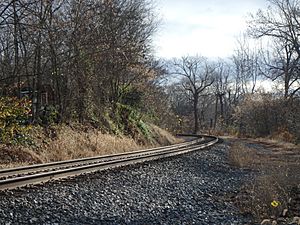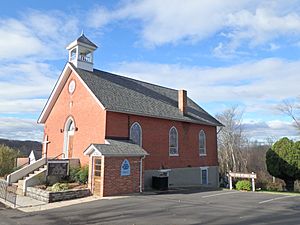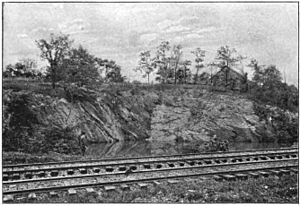Ijamsville, Maryland facts for kids
Quick facts for kids
Ijamsville, Maryland
|
|
|---|---|
 |
|
| Country | |
| State | |
| County | |
| Elevation | 106 m (348 ft) |
| ZIP code |
21754
|
| GNIS feature ID | 585127 |
Ijamsville ( /ˈaɪəmzvɪl/ EYE-əmz-vil) is a small place in Frederick County, Maryland, United States. It's an "unincorporated community," which means it doesn't have its own local government like a city or town. Instead, it's governed by the county.
Ijamsville is about 7 miles (11 km) southeast of Frederick. It was named after Plummer Ijams, who settled there. The area was once known for its high-quality slate rock, which led to a brief time as a mining town. Later, it became a farming community. In more recent times, Ijamsville has grown into a residential area, with many people living there and working in nearby cities like Frederick, Baltimore, and Washington, D.C..
Contents
History of Ijamsville: From Farms to Suburbs
Early Settlers and the Town's Name
In 1785, a man named Plummer Ijams moved to Frederick County, Maryland. He bought a large piece of land called the "Paradise Grant." His family had come from Wales and settled in Maryland in the 1600s.
Plummer Ijams started a farm on his new land. He grew crops like wheat and barley. He had two children, Plummer II and John. Plummer Jr. built a gristmill (a mill for grinding grain) near Bush Creek. John became a captain in the War of 1812. Plummer Ijams Sr. passed away in 1796, but his family stayed in the area for many years.
Other families, like the Musetters, Montgomerys, and Riggs, also settled nearby. In 1800, the Duvall brothers found large amounts of slate rock. By 1812, there were two slate quarries (places where rock is dug out of the ground) operating. This special blue-green or purple slate, sometimes called "Ijamsville phyllite," helped the community grow.
Around 1831, the early B&O Railroad wanted to build railroad tracks through the Ijams family's land. Plummer II agreed, but only if they built a depot (a small train station) there. This would make it easier to transport the slate. The railroad called the area "Ijams' Mill and Bantzs' Slate Quarries." On March 13, 1832, the first horse-drawn train cars traveled through the town on their way from Baltimore to Frederick.
In 1786, the Ijams family asked for a post office to be built. This was the first time the area was seen as a community. The post office was finally built in 1832, and Plummer II became the first postmaster. On June 22, 1832, the U.S. Postal Service officially shortened the town's name to "Ijamsville."
Growth and Development in Ijamsville
Over the next few decades, Ijamsville grew into a busy mining town. Many Welsh immigrants came to work in the slate mines, which now used steam-powered machines. A new neighborhood was built north of the railroad tracks for these workers. Many homes had roofs made from local slate. Ijamsville slate was even used in Frederick and Washington, D.C..
Small shops opened in the town center to serve the residents. A. K. Williams's General Store was very important. It housed the post office and the B&O railroad ticket office. This building stood for over a hundred years. By 1887, Ijamsville had many businesses, including a coppershop, carpenter's shop, wheelwright (someone who makes and repairs wheels), stable, boardinghouse, shoemaker, and milliner (someone who makes or sells hats). The old gristmill and a sawmill (for cutting wood) were also still operating.
In 1854, residents started raising money to build a church. Local Episcopalians donated land. A farmer made the bricks, and the women of the town sold quilts to help raise money. The roof was made of local slate. On July 25, 1858, the Ijamsville Methodist Episcopal Church was officially opened. The church's basement served as the local school until 1876. Then, a separate building was built next to the church for the students.
Local farms continued to grow crops like wheat, barley, corn, and tobacco, and raised sheep. Flour and slate from Ijamsville were well-known in Baltimore and Frederick. For a short time, Ijamsville almost had a pottery industry. In 1863, a potter named Artemus Wolf found that the local soil was perfect for making pottery. He started selling "Wolf and Sellman" pottery, which was very popular. However, he died in 1876, and the pottery business ended.
Shift to Farming and Community Life
During the Civil War, the demand for slate dropped, and there were fewer workers. Also, the B&O railroad complained that the quarries were damaging their tracks. Because of these problems, many quarries closed by 1870. The town became much smaller, with only 71 residents listed in the 1880 census.
With mining ending, Ijamsville became a farming town. Land was affordable, and farmers could grow a lot of wheat, corn, tobacco, and hay. The farms changed owners over the years but stayed mostly the same until the 1940s.
An important resident was Mrs. Eliza Ijams. Because her two children were deaf, she became involved with the Maryland School for the Deaf in nearby Frederick City. Her granddaughter, Mollie Ijams, was one of the school's first graduates.
Another local school, the Glenellen Academy, opened in 1874. It taught science and charged $100 a year for tuition. It had about 40 students and continued to offer lessons even after it officially closed in 1888.
One of the slate quarries reopened from 1913 to 1937, shipping a lot of slate and shale daily. However, after 1925, more people had automobiles, and the railroad became less important. The Ijamsville train depot was no longer used. When the quarry closed in 1937, there was no longer a reason to mine in Ijamsville, and no quarries have operated there since.
Life at the Turn of the Century
By the early 1900s, only the town's flour mill and creamery were doing well. By 1925, only an antique shop and bakery remained. Ijamsville was a "quiet country village." The Methodist church and its Homemakers' Club were the center of social life. The old school building became a social hall for the church in 1932. After that, students from Ijamsville went to schools in nearby Urbana, Maryland.
Ijamsville also had a champion baseball team that played on a field called Moxley Field. This team was very popular and was almost like a training team for the Orioles.
Another important place was a special hospital called "Riggs' Cottage." Christopher Riggs built the building in 1862. His son, Dr. George Henry Riggs, who was a physician and psychiatrist, turned it into a "sanatorium for nervous and mental health disorders" in 1896. It helped over a thousand patients until it closed in 1969. During World War I, it only treated female patients because there weren't enough male nurses.
Modern Growth and Suburban Life
Ijamsville remained a quiet farming town for most of the 20th century. Its few businesses gradually closed or changed. The hospital became a French restaurant. The baseball field was bought by the Frederick Pony Club. Many old buildings were torn down. The post office closed in 1983.
Without a post office, train depot, or many businesses, new farmers weren't attracted to the area. As older farmers passed away, their land was sold. By 1989, developers started buying large amounts of land. After building wells and septic fields, the area grew quickly. Many houses were built for families looking for work in Frederick, Baltimore, or Washington, D.C.
By 2000, Ijamsville had three main parts:
- The original town center near the railroad tracks, with some historic homes.
- Several large family farms, mostly raising cows, corn, and soybeans.
- Large areas of suburban-style homes.
New businesses came to serve the growing number of families. These included golf courses and a petting zoo.
Two religious centers were also built: a Roman Catholic, Jesuit church (Saint Ignatius of Loyola parish) and the Hindu Sri Bhaktha Anjaneya Temple. This temple is special because it's the "only [Hindu] temple in the United States dedicated to [Bhaktha]-Anjaneya." The temple was finished in 2014-2015, and the church has been there since the 1980s.
A Quaker school called Friends Meeting School (FMS) moved to the area in 1997. It started for younger students but expanded to serve pre-K through 12th grade by 2013. Another church, the Christian Life Center, built a new building in Ijamsville in 2013.
Education in Ijamsville
The Frederick County Public Schools system runs the schools in the Ijamsville area. Some schools with Ijamsville postal addresses include:
- Oakdale Elementary School
- Oakdale Middle School
- Urbana Middle School
- Windsor Knolls Middle School
- Oakdale High School
- Urbana High School
Famous People from Ijamsville
- Danielle Corsetto, a comics artist
- Shawn Hatosy, an actor
- Zack Mills, an American football player
Images for kids
-
Cow pasture at the corner of Ijamsville Rd. and Mussetter Rd.















